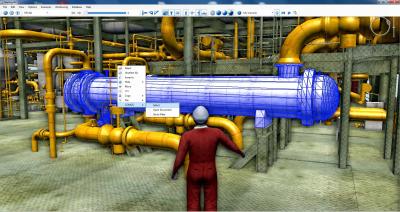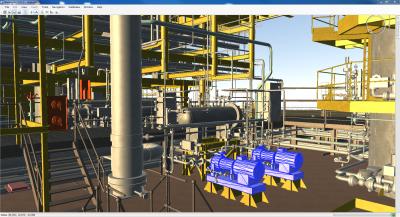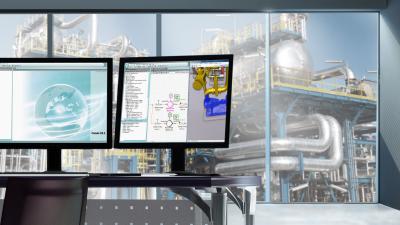Siemens‘ COMOS Walkinside software converts the engineering data for even the most complex industrial systems like refineries, offshore drilling platforms and chemical plants into realistic 3-D models.
All stakeholders, including operating personal, development engineers and even management decision makers, can use an avatar – controlled, for example via a game pad, just as in a computer game – to explore a future system even during the design phase, and help influence its features. Welcome to the future of plant planning.

The following is an interview with Manuel Keldenich, Product Marketing Manager for COMOS Plant Engineering Software at Siemens.
Mr. Keldenich, COMOS Walkinside lets practically anyone explore a 3-D model of an offshore drilling platform using a game pad or mouse. That sounds a lot like a computer game.
Yes, it is. In fact the software was inspired by computer games. The idea was to take advantage of the kind of high-resolution graphical display and easy navigation through 3-D virtual reality landscapes that were developed for computer games in the late 1990s, and to use those techniques in plant planning.
Did the project also use game development know-how?
To a certain degree. But the data volumes we work with in plant visualization are many times greater than in something like a PC game. COMOS Walkinside, for example, can model an installation in 3-D virtual reality with more than 1 trillion polygons – the little triangles that graphics are composed of – without distortion and realistically. The user can take his avatar through the entire offshore platform, from one end to the other, in real time, and get an accurately displayed look at all the equipment in the system, whether pipes, pumps or other components like the steel construction, stairs, or surfaces. Because of how we’ve handled these data volumes, Walkinside is practically in a league by itself.
Where is the economic benefit of an application like this? Or is it really just playing games?
No, COMOS Walkinside is definitely not playing games. It offers significant value added for our customers. Training personnel plays a very important role for installations in the oil and gas industry, such as those offshore platforms or also refineries. For one thing, companies have to comply with very strict guidelines for occupational safety, environmental protection and documentation. For another, everything has to be in exactly the right place for smooth real-time operation. That means that the mere sequence of individual work processes can decide whether a system runs reliably and safely, and thus cost-effectively, or whether there might be a malfunction which could result in equipment damage and economic loss even in the best case, and in the worst case environmental damage and injuries to people as well. We can help prevent events like those first of all thanks to the permanent availability of all relevant systems data from COMOS as a global data center, and also through appropriate training in a realistic working environment.

And staff can be trained like that with COMOS Walkinside.
Exactly. Here we offer companies two advantages. First, training can start while the system is still under development or under construction. So staff know the equipment even before it actually exists. And second, training can be conducted much more fully, more safely and more economically than it would be on location with operations already running. Moreover, training can be conducted anywhere in the world, independent of location. In other words, my operating personnel can train realistically in Europe or Africa, for example, for an offshore oil platform that is still in the dock in Korea. Besides Standard Operating Procedures – SOPs – you can also simulate communication with colleagues in the control room, and improve it.
Is training the only thing it can be used for?
No. It’s true that our customers are already using COMOS Walkinside very extensively and successfully for training. But the application’s great strength is not just 3-D visualization, but its direct access to all engineering data and the ability to use them over the system’s entire life cycle – in other words, engineering, handover of the installation, efficient operation, and finally demolition. That means the application can be used for design reviews as early as the engineering phase, because it displays the current planning status in an appealing way for everyone involved in the project. That way, no matter where they’re located or what their specialty is, they can test the model together, and everyone has the same level of information. In other words, the engineer can see precisely where a pump will be installed, how pipes will run and where a valve will be located. The occupational safety officer can also point out issues directly, for example if passageways are designed to be too narrow. Since we work with avatars, so to speak from the user’s perspective, details can be planned and checked much faster and more effectively. That saves considerably on the costs that would be incurred for modifications or revisions later on in the project, or even during operation. It’s precisely the connection between the 3-D visualization, COMOS as a central database for all engineering data, and integration with the SIMATIC PCS7 process control system that makes our solution so interesting for everyone involved, and most of all, unique!
Mr. Keldenich, 3-D visualization doesn’t seem like anything that extraordinary, at least at first glance. How are customers from industry responding to the concept of plant planning and tours in virtual reality?
As I already mentioned – a complete 3-D virtual reality visualization of an entire plant based on complex engineering data isn’t as prosaic as it might seem at first glance. The key point isn’t just the 3-D visualization. What’s crucial is that you can see the all relevant details of the system, and that changes in the database are adapted and displayed almost in real time. A user can use the plant structure in the 3-D model to easily single out items of equipment or pipelines and go straight to them. The software also has a lot of other useful functions for users, like the ability to show and hide objects, or different perspectives and views, so that each customer can adjust their own 3-D environment very specifically.

Is the application reserved for engineers only?
Not by any means. It also provides a view of the plant’s current status and data for decision-makers in management, controlling, occupational safety, and especially subcontractors and partners who are not fully involved in the engineering proper and the design, without requiring any specific expertise on their part. In practice, that makes it significantly easier to work together on projects worldwide, across disciplinary boundaries, and thus to arrive at decisions.
The software is already available and in use. What’s the next step? What additions to COMOS Walkinside are you currently at work on?
We’re currently working on expanding the user spectrum to other process industries and to additional use cases. Other important topics are global collaboration, of course, and interoperability or integration with other Siemens solutions like the SIMATIC PCS 7 process control system, so as to generate unique customer advantages. Technologically, we also have to continue working on tie-ins with 3-D hardware, like data glasses or equivalent displays. And lots of new possibilities have opened up in recent years in terms of “Kinect†– in other words, control through gesture recognition.
Sounds a bit like the Holodeck we know from the Star Trek series.
In a way, of course, our goal is to provide the most realistic experience possible, especially when you think about the training aspect. That’s why we’re also optimizing the way we display the avatars. We want users to be able to customize their avatar’s look more, and movement patterns are constantly being expanded, so people can do things like climb ladders, and so our avatars can even swim! Details like using personal protective equipment like helmets and protective breathing masks is also a part of that. We’re also fine-tuning events in the system to be even more realistic. For example, a training instructor can arrange a fire or gas leaks and thus simulate malfunctions during the training process for when people are working later on the real system.
What other trends do you think are important?
Very clearly, we’re carefully watching the trend toward displaying plant models on mobile terminal devices like tablets, and the increasing networking of project teams directly online and also in the Cloud. But even today, using COMOS Walkinside, teams from various locations around the world can already work simultaneously on a project. Here too, there are different requirements and functions for central units in Design Review, plant operation and training that our users are likely to welcome enthusiastically in the future.
For more about the platform, check out these videos:
(Article adapted with permission from Siemens Competitive Industries blog.)
- 3D gaming tech in industry - March 10, 2014
